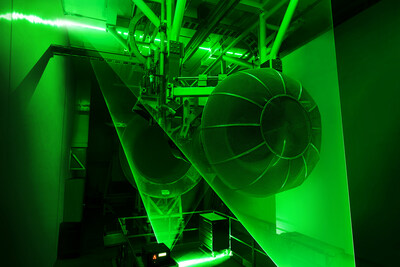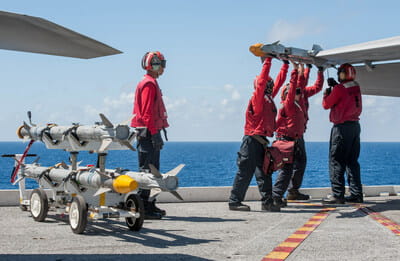Multi-domain operations: Helping militaries make better decisions faster
For years, Paul Meyer’s job in the U.S. Air Force was to suppress enemy air defenses. To do that, he had to know where they were and what they were doing. And to do that, he and the pilot of his F-4 Phantom II had to get close enough to show up on their radars.
“My job was to play chicken – to put myself in that environment where I have to fire my missile before he fires his,” said Meyer, a retired weapon systems officer and now president of Department 22, the next-generation military technology arm of Raytheon Intelligence & Space, a Raytheon Technologies business.
Today, Meyer and many others at Raytheon Technologies are working in support of a massive U.S. Department of Defense initiative that would make such tactics a thing of the distant past. That effort, known as Joint All Domain Command and Control, or JADC2, aims to put intelligence from any sensor – on land, at sea, in the air or in space – in the hands of any military operator or commander who needs it.
JADC2 is a leading example of what’s known as multi-domain operations, the idea that military forces around the globe can operate faster, more collaboratively and more effectively by using commercial-style data networks that collect, process and distribute enormous volumes of information within seconds.
“Military departments today have limited data-sharing capabilities and latency challenges. Data is stovepiped across systems. It’s like a bunch of soda straws relaying information unilaterally to other assets, and it’s not widely and easily available to military commanders who are making mission-critical decisions,” Meyer said. “We’re solving for that by designing data-centric technologies that are interoperable and open to deliver the right data at the right time so military commanders can make the right decisions faster.”
Here’s how experts across Raytheon Technologies are bringing that idea to life.
Aircraft from Carrier Air Wing 9 fly over several U.S. Navy ships in formation during Valiant Shield 2022, a training exercise where the U.S. armed services operated together across military domains. (U.S. Navy photo)
Multi-domain operations begins with sensing. Across the military domains, there are thousands of radars, electro-optical/infrared systems, sonars and other types of sensors all doing essentially the same thing: monitoring the environment and rapidly assessing the changes.
The key concept behind multi-domain operations is that changes in one of those environments can be useful to military operators in another – either as a warning, or as a cue to act.
The U.S. military demonstrated how this would work in June 2022 during a joint exercise called Valiant Shield off the coast of Guam. In that exercise, a converted Boeing 727 known as the Raytheon Intelligence & Space Multi-program Test Bed, or RMT, used a combination of radar and electronic intelligence sensors to detect and describe a simulated threat at sea.
Onboard processors synthesized the data in seconds, calculated a targeting response and passed it autonomously to the tactical platforms tasked with defeating the target. Doing that required sharing data among the RMT, along with a KC-135 aircraft, four U.S. Navy F/A-18 fighters and a command-and-control station on the U.S. mainland – all in an environment that simulated a highly contested battlespace.
In the near future, sensors will routinely do more than simply gather and pass on information. They’ll perform certain intelligence and targeting tasks on their own – functions that historically have taken place at large ground stations and required around-the-clock, long-distance connectivity.
“We are paving the way for autonomous, smart sensors at the leading edge today,” Meyer said. “The velocity and complexity of modern peer-to-peer conflict requires it.”
Connect
A KC-135 aircraft – a plane traditionally used for refueling bombers and tactical fighters – can double as a communications node to the joint force.
The Valiant Shield exercise showed the value of not only collecting vital information from across the military domains, but delivering that information in a timely way to the people and platforms in a position to respond. That requires a level and pace of networking never before seen in defense.
“You can sense something, but if you can’t send that data to the platform that’s going to act, you can’t execute the mission,” said Elaine Bitonti, vice president of JADC2 experimentation and demonstration at Collins Aerospace, a Raytheon Technologies business.
Making those connections requires open systems that use multiple types of waveforms and networks to communicate, even in highly contested environments. And in turn, making those networks suitable for many types of military users requires innovative ways to manage and secure data amid the rigors of battle.
Raytheon Technologies already has a strong presence in secure communications across the military services. Collins Aerospace provides
jam-resistant advanced tactical data links that are critical to connecting sensor data to operators on the edge of the battlespace.
Raytheon Missiles & Defense, another Raytheon Technologies business, is working with research and development organizations across the military to use cutting-edge approaches such as software-defined apertures, intelligent information distribution and multi-level security – a way to ensure operators can access the right data on the right networks. Those methods would help link platforms and synchronize their actions across extremely long distances in contested environments.
Apart from protecting data against unauthorized access, a multi-domain operations network would also have to handle the complications of international forces operating collaboratively. If a navy knows, for example, that a swarm of low-flying UAVs is heading into a friendly force’s airspace, it has an obligation to tell them right away – but it might need to keep other details secret, such as the source of the information.
In multi-domain operations, that would be a job for what’s known as the intelligent gateway – an oracle of sorts with multiple levels of security that would take in information from many forces across many domains, but redistribute it only to the relevant users, and only in an appropriate amount of detail.
“Users don’t always need to know what platform collected it or why that platform was in the area. They just need to know there is a valid threat,” Bitonti said.
She oversees the testing of technologies that illustrate how the intelligent gateway would work. In a 2021 demonstration at Wright Air National Guard Base in Salt Lake City, for example, Collins Aerospace showed that a KC-135 aircraft – a plane traditionally used to refuel bombers and tactical fighters – can double as a communications node to bridge the joint force.
Using Collins technology including
a cross-domain solution and an advanced tactical datalink mesh network, the KC-135 transmitted data such as images and positioning information, from multiple users, with different levels of classification. The technology also displayed that information on the aircraft's Real Time Information in the Cockpit system.
“Having something like the KC-135 that can extend the range and reach of the network is critical,” Bitonti said. “The KC-135 can be a bridge that enables wider dissemination of critical data, allowing commanders to make better decisions.”
Make sense
Raytheon Technologies is developing a prototype for the U.S. Army's Tactical Intelligence Targeting Access Node, or TITAN, ground station, which will find and track potential threats by quickly combing through immense amounts of sensor data.
Multi-domain operations systems will collect terabytes of data from thousands of sensors – some old, some new, and some that use proprietary data formats readable by only certain ground stations. Fusing all that data, interpreting it and converting it into actionable battlefield intel will be the work of artificial intelligence and machine learning.
One example of such a system is the
Tactical Intelligence Targeting Access Node, or TITAN – a forward-deployed ground station that ingests and combines large and diverse data sets to find, track and render detailed 3-D visualizations of potential threats quickly.
“Before, it took hours to get targeting-quality accuracy for an entire image,” Meyer said. “Now we’re looking at real-time targeting-quality accuracy for every pixel.”
Raytheon Intelligence & Space has proposed the system to the U.S. Army in support of the service’s part of the JADC2 effort. The system is a collaboration of three businesses: RI&S, which has decades of experience in integrating complex systems; Collins Aerospace, which contributed its expertise in open-systems architecture – a key feature for the military’s desire for fast and efficient upgrades – and the AI software company C3.ai.
Artificial intelligence will bring more than speed, Meyer said – it will enable even single operators to work on a much larger scale.
That’s what happened when
Raytheon BBN demonstrated a software system known as ARAKNID in a multinational exercise led by the U.S. Northern Command. In that exercise, the software evaluated scenarios, then suggested courses of action to a U.S. Air Force commander. Based on the commander’s choices, the software then assigned multiple assets, including several fighter jets, to respond – reducing the time it took to get them in the air and increasing their chances of a successful intercept.
“Today, there are several people per asset. We’re developing systems to invert that,” Meyer said. “In the future, there will be many assets per person. This increases the scale for operators to complete not just one, two or three courses of actions, but hundreds simultaneously.”
Act
Effectors – a term that encompasses missiles, mortars and non-kinetic weapons – have two main roles in multi-domain operations: to defeat targets and to create data of their own.
Everything up to here – the sensing, the connecting, the data analysis, leads to one question: What are you going to do about it?
The answer often includes effectors, a military term that encompasses missiles and mortars, lasers and high-powered microwaves, jammers, decoys and cyber responses – essentially, anything a military can deploy to cause a change in the target.
Multi-domain operations would allow forces to use those systems much more effectively and efficiently, said Thad Smith, director of customer requirements and capabilities for Raytheon Missiles & Defense.
“Effectors are the last element of that network – the last thing you want to use,” said Smith, a former U.S. Navy surface warfare officer. “That’s the purpose of the network – to be able to use as minimal number of effects downrange as possible against targets, so we can achieve the desired effect we want in that moment.”
One example, he said, is the potential for precision weapons to feed battle-damage assessments into the network. If a network-enabled weapon such as the
StormBreaker smart weapon can report that it has destroyed an adversary airfield, he said, there’s no need to launch a second, or to deploy intelligence aircraft to confirm.
Networking sensors and effectors can also have a deterrent effect, he said, particularly the more the U.S. and its allies talk about how they’re developing capabilities in that area. If adversaries know forward-deployed aircraft can share information seamlessly with surface ships and ground forces, he said, “that’s a deterrent in itself.”
“Now they have to do the calculus,” he said. “They were going to operate in this region of the ocean. Now they can’t – that’s a keep-out region.”
Network-enabled effectors could even be used to gather intelligence on how adversaries operate, Smith said. If a naval force were planning an operation to the west, he said, they could first launch a volley of decoys to the east to study the adversary’s response.
“It’s this chess match you’re always playing. Every time an enemy makes a maneuver, it just moves pieces on that chessboard. It exposes their thought process and their response rate, and it helps me construct my decision timeline,” he said. “It either accelerates our response or gives us more time to think through options other than effects on target, which, frankly, is the goal. Nobody wants to use effects until they have to.”









